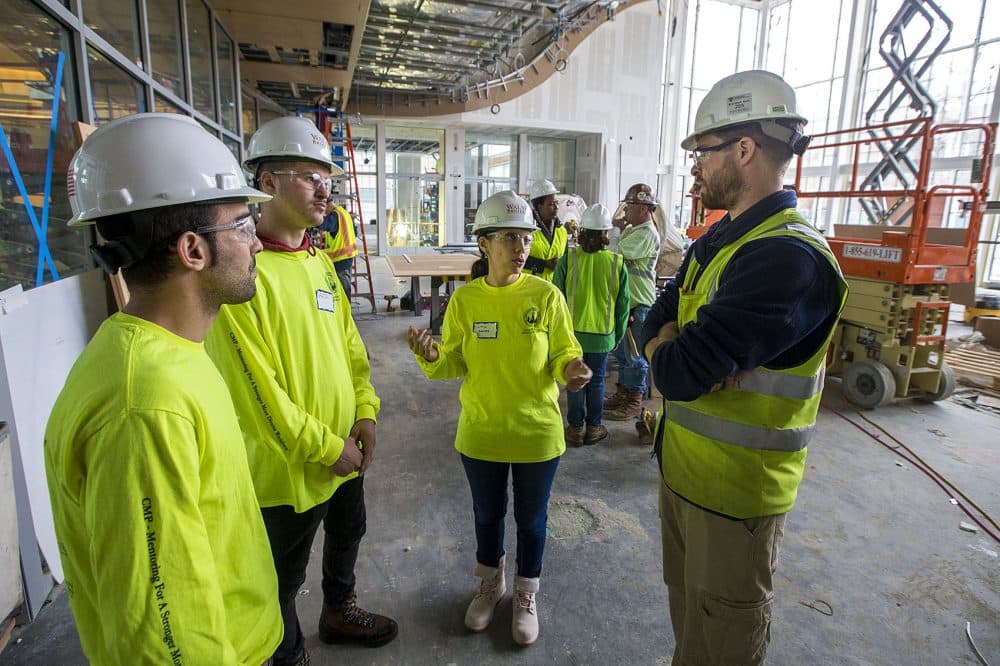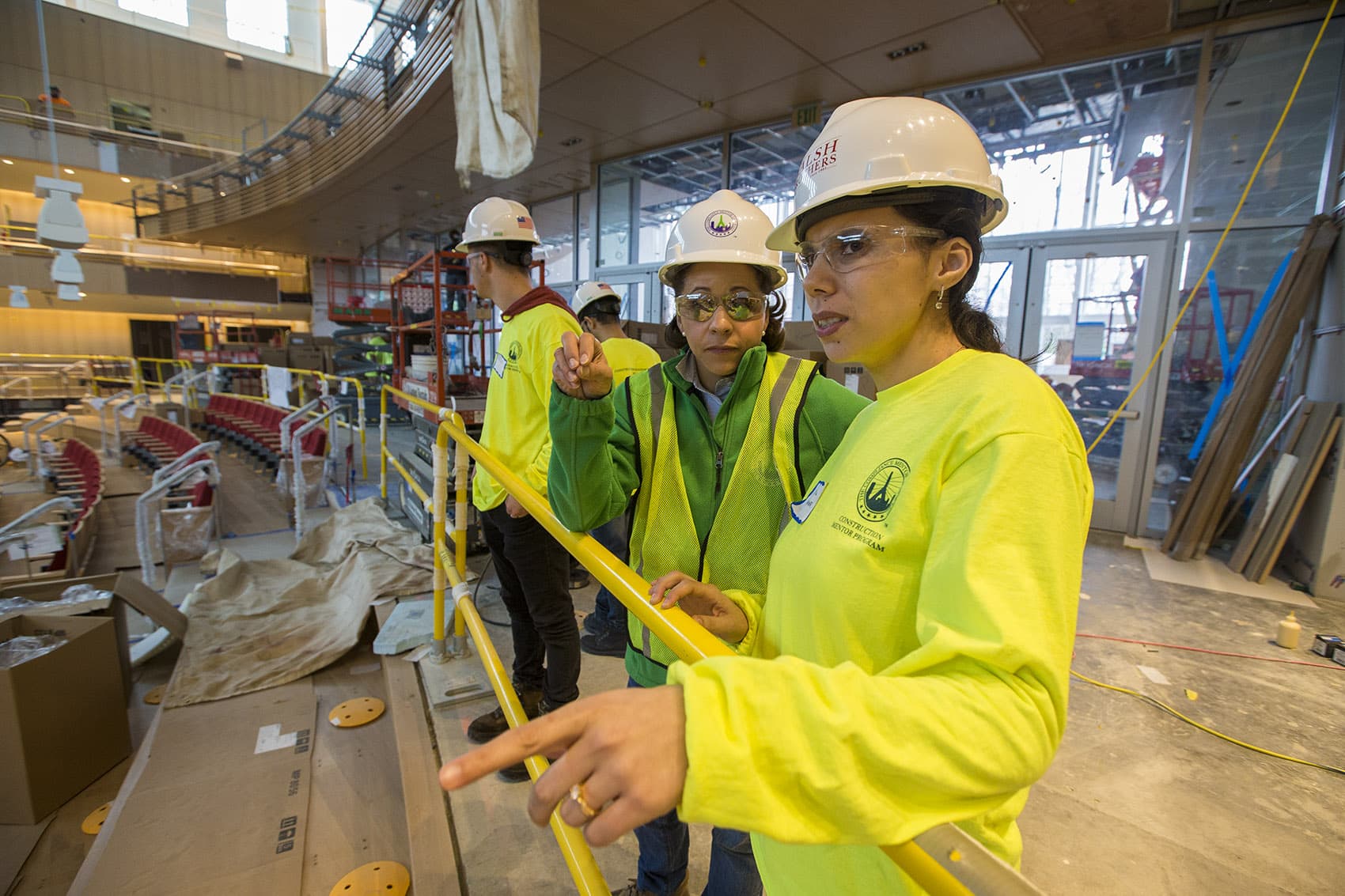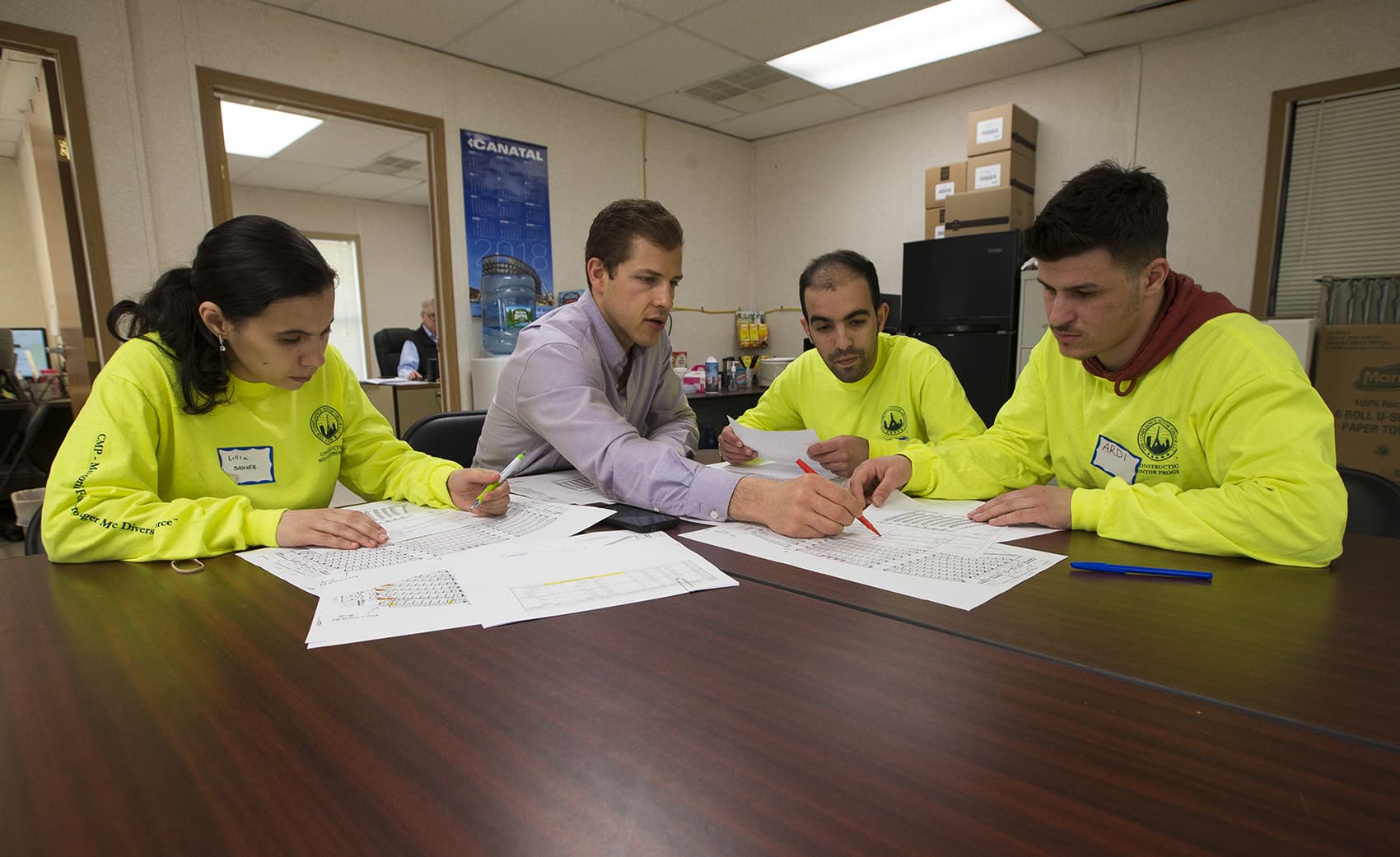Advertisement
Boston Is In A Building Boom — And Wants More Diverse Construction Workers
Resume
Throughout Boston, cranes and steel structures pepper the city's landscape. Boston is in a major building boom. And the city needs construction workers to keep up.
There's also a gross imbalance of women and minorities in this industry. So, training and outreach are a priority.
You can see some of these efforts over at Harvard Business School in Allston, where a new $100 million facility takes shape. The development -- called Klarman Hall — will be what the school calls a "convening hall."
"It’s for when keynote speakers come to Boston," explains Aidan Buick, an assistant superintendent on the site for general contractor Walsh Brothers. "It's going to be top of the line, state of the art acoustically, so Harvard will try to pull them in here."
A group of college students clad in hardhats and neon shirts shadow Buick on a recent afternoon. The sounds of drilling, cutting and hammering reverberate throughout the hall. Workers place seats in front of the stage. And in another room, "acoustical ceiling tiles" are ready to be installed.

The students are part of the Construction Mentor Program, started six years ago by Nicole Richer, a former construction manager. They've been on the site at various points in the building process.
"They get to see three different mentors on the job site in action and get to ask questions," Richer says. "It's another way of recruiting students and reaching out to community schools and finding emerging talent."
Richer was a project manager for over 18 years. She says it’s not an easy world for women.
"I'm actually also African-American, so, you know, I've been one of very few people," Richer says. "At times it's been a challenge to sit at the table."
She heard racial comments and at times felt she wasn’t taken seriously or given the same opportunities for promotions or better projects. Richer says the industry has changed some since she started out and she had mentors along the way who helped her.
Now, she wants more people at the table. Like Lillia Sakher, one of the students on the site. Sakher, 29, is originally from Algeria and studies construction management at Benjamin Franklin Institute of Technology.
"When we start working, we think that it will be a routine for us, but [in the] construction management field, every day is another challenge," Sakher says. "So, I like this. I like challenges. Each project is different."

Women make up 7.6 percent of apprentices in building trades unions in Massachusetts, according to the Policy Group On Tradeswomen's Issues (PGTI), and far less in nonunion apprenticeships — just 3.7 percent.
Apprenticeships are key because they are a major pipeline into construction jobs.
Sakher believes the future is brighter. She remembers the first time she came to this construction site and saw a woman welder.
"I saw a woman doing welding, like welding steel, and I never suspect that I can see something like this," she says.
But she wants to be a boss.
"My ultimate goal [is] just to be a construction manager, a senior construction manager or both. Why not?" Sakher says with a laugh.
Sakher is the only woman in this racially diverse group of eight mentees. This summer, she’s interning with Walsh Brothers, the construction company that oversees the Harvard Business School development.
Missed City Targets
There’s another incentive to train minorities and women besides the need for more workers: The city requires diversity on construction projects.
This isn’t new. It started 35 years ago under the Boston Resident Jobs policy. Last year, the target numbers increased for the first time. So now, 40 percent of hours on a construction job must be performed by people of color, 12 percent by women and 51 percent by Boston residents. (That's up from the previous targets of 25 percent, 10 percent and 50 percent, respectively.)
"These are the numbers that we know it will take to have significant and meaningful diversity in the construction industry, and meaningful and substantive opportunity for folks in the city," says Karilyn Crockett, the city's director of economic policy and research.
The city works with developers and unions to make sure they understand the policy guidelines, Crockett says. The city shares best practices for hiring and recruitment, and runs an online jobs bank to connect workers to construction jobs.
"I'm someone who's not OK with folks saying that 'we just can't find people' because that's kind of an easy way to let ourselves off the hook," Crockett says.
But the target numbers are not being met. Last year, women represented only 5 percent of hours worked on construction projects in the city. Minorities represented about a third. Out of 191 construction projects in 2017, only five met all three benchmarks — and none of the biggest projects in the city.
If companies don't take steps to address the missed targets, they face penalties. This includes a $300 fine for each violation, or termination of a contract for repeated violations.
Richard Walsh, who heads his family’s 117-year-old business, Walsh Brothers, says people scrambled to meet the guidelines in the earlier days of the jobs policy.
"Horrible things would happen where someone would hire one female worker and she'd go around and sign the roster on all five jobs as if she were working at all those," Walsh says. "But those are, as I call them, shenanigans."
Walsh says now focus in the industry has shifted to the talent pipeline and recruitment. Klarman Hall has 133 workers. Of those, 41 are Boston residents, 39 are people of color and eight are women, according to the company. Walsh says his company still has work to do but has been moving closer to the goals over time.

Trade groups are also working towards the diversity goals. The electrical workers union, IBEW Local 103, did an ad campaign in neighborhoods with large minority populations — including Dorchester, Roxbury and Mattapan — and doubled the number of applicants for its apprenticeship program. The union now expects to have its most diverse class ever this fall.
"The easiest way to change the face of your union is to go by the apprenticeship," says Lou Antonellis, the union's business manager. "We're moving in the right direction and I think it's a great start."
There's also the tradeswomen's group PGTI that aims to have 20 percent women in the building trades by 2020. The group does workshops and trainings in schools and works with developers to set workforce goals.
"Our focus is the tradesworkers because somebody who’s currently breaking their back working three jobs and never gets to see their kids and is barely making ends meet can become a union carpenter and start making a decent salary," says Liz Skidmore of PGTI.
And the state’s largest general contractor — Suffolk Construction — has a new executive post for diversity, headed up by a woman.
Linda Dorcena Forry was the only black member of the state Senate. Now, she’s vice president of diversity, inclusion and community outreach at Suffolk.
"Did I ever think I would end up here? Probably not, right," she says.
Her role is to make sure diversity runs through the DNA of the company, according to Forry.
"We want to set the stage for the industry that it's not just talk. You know when people talk about diversity and inclusion [like] 'Hey, we're doing D and I.' No, we really mean it," Forry says.
She started in March — the first person to hold the role at Suffolk — and is new to the construction industry. So, she’s been studying up on best practices in other industries and ways to partner with local schools to recruit students.
She also wants to bring some of her state Senate work on small businesses to the table. Forry hopes to pull more women and minority-led businesses into the fold on Suffolk’s development projects.
"It's not about window dressing," Forry says. "This is really about the work and recognizing that, you know, this is an incredible time ... to give opportunities to women and to people of color that have been left out, you know, in terms of this industry. And this opportunity … is critical when we talk about closing the wealth gap."
Jobs in the industry also pay well. An apprentice could start at $20 an hour and go up to $50 an hour once in a job — all with full benefits.
Not bad for a city with high rents and high income inequality.
Above table best viewed on desktop, or rotate your mobile device.
Data analysis and graphics by Ally Jarmanning.
This segment aired on June 13, 2018.
